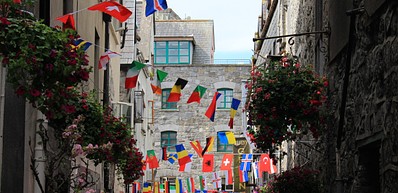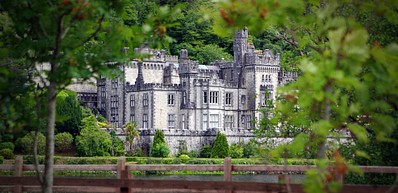
-
![Connemara National Park in Galway County]() Provided by: Stewjules/cc by-sa 4.0/Wikimedia
Provided by: Stewjules/cc by-sa 4.0/Wikimedia

Our travel guides are free to read and explore online. If you want to get your own copy, the full travel guide for this destination is available to you offline* to bring along anywhere or print for your trip.
*this will be downloaded as a PDF.Price
€4,95
Connemara National Park
The guide was updated:Covering about 2,000 hectares of scenic mountains, sprawling bogs, heaths, grasslands, and woodlands, the Connemara National Park offers a glimpse of this rich terrain, which has long been a place of discovery and exploration.
The Park encompasses a section of the Twelve Bens mountain range, including the county's tallest peak, Benbaun, which stands at 725 metres. Four hiking trails are available to visitors. One of its highlights is reaching the summit of Diamond Hill, which rewards you with a breathtaking panorama of Tully Mountain, Kylemore Abbey, and the Twelve Bens.
Useful Information
- Address: Letterfrack, Galway
- Opening hours: The Park is open 24/7. The visitor centre is open daily 9am–5:30pm
- Tickets: Entry to the park is free of charge
- Website: www.nationalparks.ie/connemara
- Phone: +353 76 100 2528
Digital Travel Guide Download
Our travel guides are free to read and explore online. If you want to get your own copy, the full travel guide for this destination is available to you offline* to bring along anywhere or print for your trip.
*this will be downloaded as a PDF.Price
€4,95

For a taste of Galway's unique character and charm, be sure to visit the Latin Quarter. A vibrant and historic neighbourhood located in the heart of the city, known for its colourful buildings, bustling pedestrian streets, and lively atmosphere. The Latin Quarter is home to a variety of shops, restaurants, bars, and cultural attractions. Visitors can explore landmarks such as the Spanish Arch and St Nicholas' Collegiate Church, shop for artisanal crafts and souvenirs, and enjoy traditional Irish music and dance performances in the many pubs and venues.
Read more

Aughnanure Castle
Built in the 16th century as a stronghold of the O'Flaherty clan, Aughnanure Castle — a six-storey tower on the shores of Lough Corrib — crowns the picturesque scenery of Oughterard. Today, visitors can explore the remains of the castle's banqueting hall, a watchtower, an unusual double bawn and bastions, and a dry harbour.
Read more

Brigit’s Garden
Escape into a world of natural beauty and enchantment by visiting Brigit's Garden. Regarded as one of the most picturesque gardens in Ireland, Brigit's Garden is a magical Celtic-themed garden surrounded by 11 acres of wildflower meadows. The nature trail, stone chamber, and nature discovery trail will spirit visitors of all ages into a world of imagination.
Read more

Connemara National Park
Covering about 2,000 hectares of scenic mountains, sprawling bogs, heaths, grasslands, and woodlands, the Connemara National Park offers a glimpse of this rich terrain, which has long been a place of discovery and exploration.
The Park encompasses a section of the Twelve Bens mountain range, including the county's tallest peak, Benbaun, which stands at 725 metres. Four hiking trails are available to visitors. One of its highlights is reaching the summit of Diamond Hill, which rewards you with a breathtaking panorama of Tully Mountain, Kylemore Abbey, and the Twelve Bens.
Read more

Dún Aonghasa
Perched on a cliff overlooking the Atlantic Ocean, Dún Aonghasa is the most monumental of the prehistoric stone forts on the Aran Islands. This semi-circular structure, which is over 3,000 years old and enclosed by three massive stone walls, has yielded significant evidence of prehistoric metalworking and various ancient burial sites and settlements through excavations.
Visiting Dún Aonghasa requires a short hike over uneven terrain and natural rock formations, so it's recommended to wear sturdy walking shoes or boots. Also, be extremely careful when approaching the cliff's edge since there is no fence or barrier at the edge of the 87-metre drop.
Read more

Kylemore Abbey & Victorian Walled Garden
Home of the Benedictine nuns for the past 100 years, the 1000-acre-wide Kylemore estate is a perfect day trip destination. Take a guided tour and discover an award-winning Victorian Walled Garden, which often hosts musical performances.
Read more

Druid Lane Theatre
The award-winning Druid Theatre is one of Ireland’s premiere theatre companies, featuring both classic and contemporary performances. Check out their programme for a taste of local culture.
Read more

Galway Atlantaquaria — National Aquarium of Ireland
The National Aquarium of Ireland is home to the country’s largest collection of aquatic life, with over 150 species of fish and invertebrates. The exhibits provide a unique insight into native marine and freshwater habitats, a perfect opportunity to learn more about the sea which characterises Galway.
Read more

Galway City Karting
Galway City Karting is Galway’s only indoor karting venue. A fun and safe environment to chase high speeds, the venue is family-friendly with karting options for children from 7 years and up.
Read more

Galway City Museum
Located on the banks of the River Corrib, the Galway City Museum is a spacious and modern building, where visitors can learn all about the city's unique character, with displays on archaeology, local history, art and craft.
Read more

Athenry Heritage Centre
Enjoy an immersive medieval experience in the Athenry Heritage Centre. Get into character by borrowing a medieval costume, and try your hand at Archery. The museum is fun for all ages and offers interactive exhibits as well as guided tours.
Read more

Irish Workhouse Centre
This humbling museum offers insight into an often overlooked institution in Irish history — the Workhouse. From the 1840s until Independence (1920s), Workhouses were the last resort for the destitute poor. Offering minimal living conditions in exchange for gruelling work, these institutions characterise the hardship of life in the era. The centre is composed of 7 workhouses and takes visitors on an interactive journey through this harrowing chapter of history.
Read more

Menlo Castle
Nestled in a picturesque location on the banks of the River Corrib lies the secluded Menlo Castle. Built in the 16th century, this historic castle has since been reclaimed by nature, making it a challenge to spot behind the lush green vegetation that now covers it.
From 1600 to 1910, the castle was home to the Blake family, once described as the richest family in Galway. Sadly, a devastating fire broke out in 1910, claiming the lives of Lord and Lady Blake's daughter, Eleanor as well as two maids. The castle was completely destroyed, leaving only the ivy-covered walls that still stand today as a haunting reminder of the tragedy that occurred.
During the summer months, the riverside walk that follows the former Galway to Clifden railway line is a popular destination for walkers and joggers. If you happen to be in the Galway area, this scenic path is definitely worth a visit.
Read more

Céide Fields
Céide Fields in County Mayo is home to the oldest known stone-walled fields in the world, dating back nearly 6,000 years. The visitor centre offers an opportunity to learn about the spiritual beliefs and culture of the neolithic society which created this landscape. The fields are also worth visiting for their wild ecology — blanket bog, dramatic cliffs, and coastline are accompanied by rare mosses, sedges, lichens, and flora.
Read more

Croagh Patrick — Ireland's 'Holy Mountain' or 'The Reek'
Croagh Patrick is a 764-metre-high cone-shaped peak that rises above Clew Bay in County Mayo. Known as Ireland’s ‘Holy Mountain’ or ‘The Reek’ among locals, it’s a site steeped in history, religion, and mythology.
The mountain is believed to have been a pilgrimage site for pagans as far back as 3000 BC. It’s thought that pagans gathered here to celebrate the start of the harvest season. Later, it became associated with the worship of the Celtic sun god, Lugh. And then in the 5th century, Saint Patrick is said to have fasted on the mountain for 40 days and nights before banishing the snakes from Ireland.
Today, Croagh Patrick remains a popular pilgrimage site, with around 20,000 to 25,000 pilgrims climbing the mountain each year on the last Sunday in July, closest to the pagan festival of Lughnasa.
The trek to the summit is a rewarding experience, with panoramic views of the hundreds of tiny, green drumlin islands in Clew Bay, the Wild Atlantic Way, the town of Westport, and surrounding mountain ranges.
Read more


